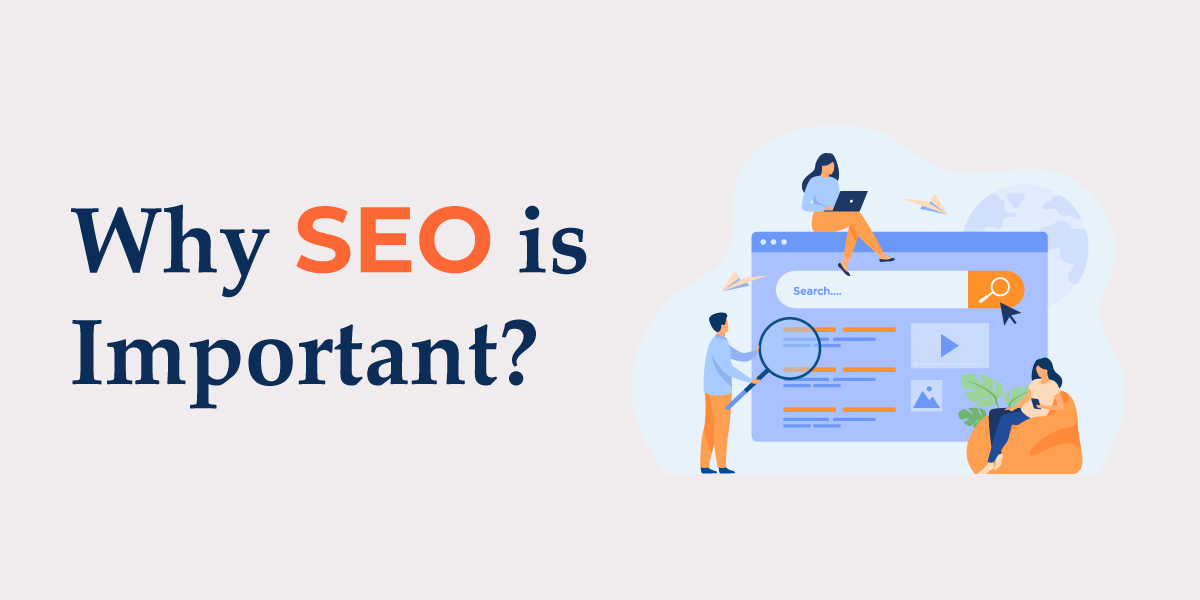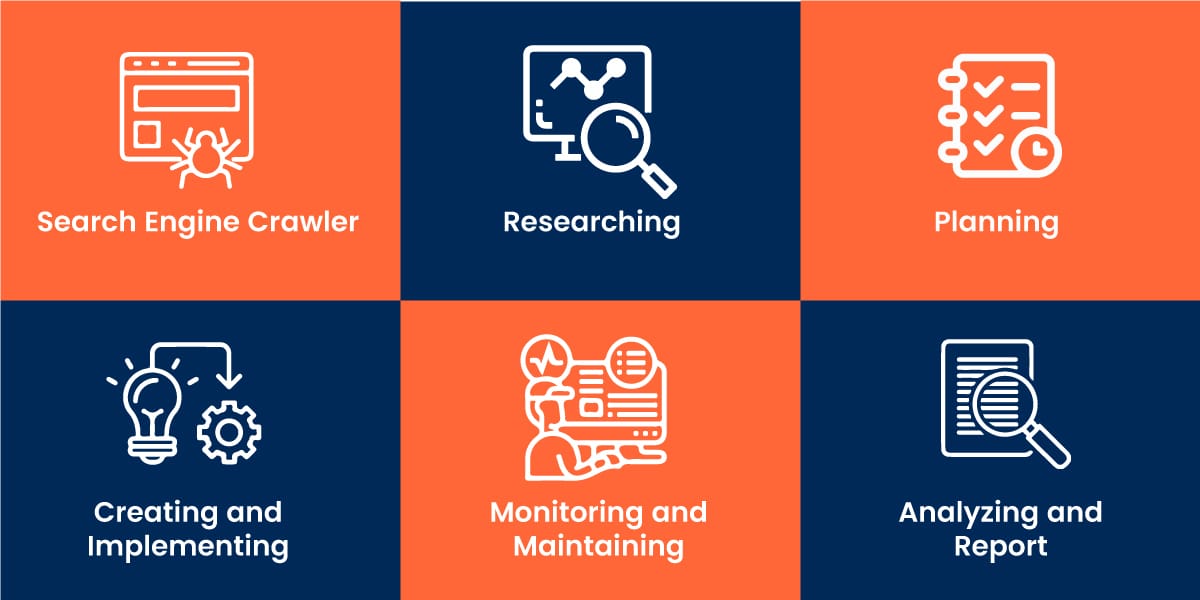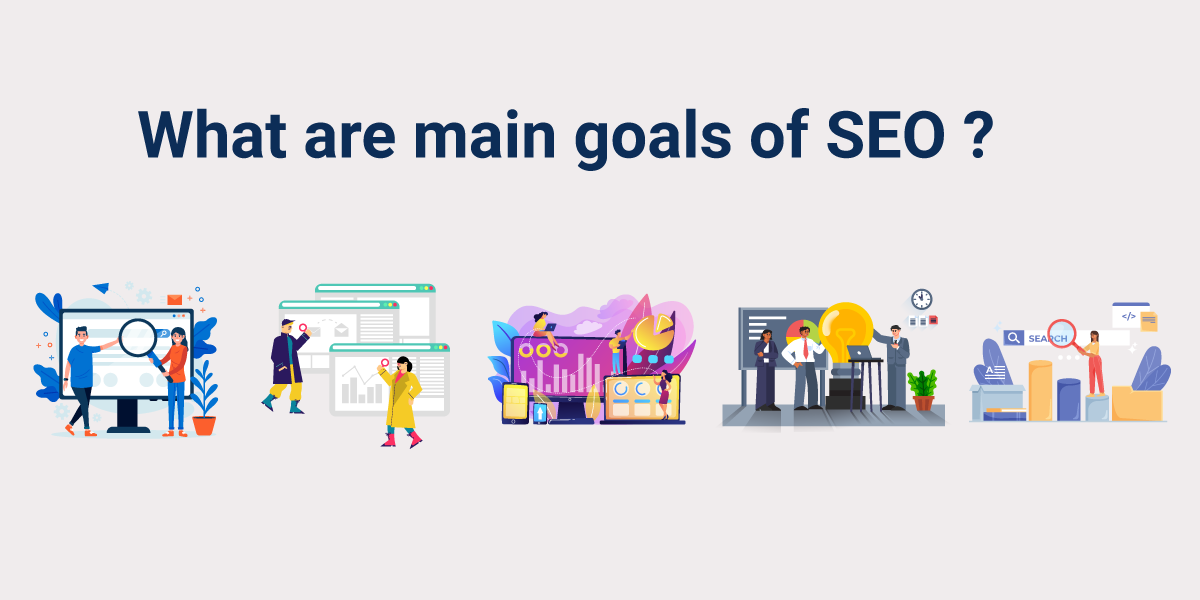What is SEO, and How Does It Work?
SEO is the buzzword. If you are looking to know what is SEO and why you should use it then this post is for you.

In the digital age, visibility is crucial. Search Engine Optimization (SEO) is a powerful tool that ensures your website stands out in the crowded online space.
What is SEO, and how does it work? This comprehensive guide delves into the basics of SEO, the importance and how SEO can benefit your business.
You might be a beginner or looking to refine your existing knowledge. This article will provide valuable insights into the world of SEO.
Basics of SEO
What is Search Engine Optimization (SEO)?
SEO is the practice of improving your website. This is to make it more visible for relevant searches. The more visible your pages are in search results the more likely you are to get attention. And attract customers to your business.
SEO includes many strategies, techniques, and tactics. They boost your site's search engine ranking. This brings more traffic and, in the end, more business.

Why Is SEO Important?
SEO is important because it attracts organic traffic. This traffic is more likely to convert than paid traffic. Organic search is often the primary source of website traffic.
An optimized site leads to better search rankings. It also brings more web traffic, conversions, and revenue.
Also, good SEO practices improve the user experience and usability of a website. They make it more appealing to visitors and ensure long-term engagement and loyalty.
How is SEO Different from SEM and PPC?
SEO vs. SEM
Search Engine Marketing (SEM) covers more. It includes organic SEO and paid strategies like Pay-Per-Click (PPC).
SEO optimizes your site to gain traffic for free. SEM combines SEO and PPC to drive traffic through unpaid and paid methods. Many see SEM as a full approach to being visible on search engines. It uses a mix of unpaid and paid tactics to reach as many people as possible.
SEO vs. PPC
Pay-per-click (PPC) is an advertising model where businesses pay a fee each time their ad is clicked. SEO aims for organic ranking.
In contrast, PPC involves bidding on keywords. This bidding gets your ads displayed at the top of the search results. Both strategies have their merits. But, SEO is more lasting and cost-effective.
PPC can give quick results. SEO builds authority and trust over time. It provides long-term benefits without the recurring costs of ads.
How Does SEO Work?

Understanding How Search Engines Work
To understand SEO, it's essential to first grasp how search engines operate. Search engines like Google use complex algorithms. They use them to decide the relevance and ranking of web pages. They do this in response to user queries.
Step 1: Search Engine Crawling
Search engines use bots. They are also known as spiders or crawlers. They crawl the internet to find new and updated pages.
These bots scan the content and follow links to index information. Crawling is the first step in the search engine process. It lets search engines find new content and understand your website's structure.
Step 2: Search Engine Indexing
Once a search engine crawls a page, it indexes it. The index is a massive database. The search engine stores all the found web pages and then makes them accessible on a search query.
Indexing ensures organizing and storing the content found during crawling well. When a user searches for relevant information, they can retrieve it.
Step 3: Search Engine Ranking
Ranking involves algorithms that test the indexed pages based on hundreds of factors to determine their relevance to a search query. Pages that score higher are displayed at the top of the search results.
Many factors influence ranking. These include keyword usage, content quality, backlinks, and user experience. The goal of SEO is to optimize these factors to improve its ranking and visibility.
Researching
Effective SEO begins with thorough keyword research. Identifying the right keywords helps you understand what your audience is searching for. And how to tailor your content to meet their needs.
Use tools like Google Keyword Planner, Ahrefs, or SEMrush. They help you analyze keyword competition and search volume. Focus on finding a mix of short-tail and long-tail keywords to cover a broad range of search intents.
Planning
Planning involves creating a strategy that aligns with your business goals. This includes content planning, link-building strategies, and technical SEO improvements.
Make a content calendar to ensure consistent publishing. Outline the types of content you will create. Plan your on-page and off-page optimization efforts.
Consider how you will add SEO to your marketing strategy. Allocate resources well.
Creating and Implementing
Create high-quality, keyword-optimized content and implement your SEO strategies across your website. Design an intuitive site with easy navigation and compelling content.
Focus on creating content. It should provide value to your audience. It should answer their questions and address their pain points.
Use on-page SEO techniques. These include optimizing title tags, meta descriptions, headers, and images. They all enhance your content's visibility and relevance.
Monitoring and Maintaining
Check your website's performance often. Use tools like Google Analytics and Google Search Console. Track your rankings, traffic, and user behaviour to ensure your SEO efforts are paying off.
Monitoring lets you find issues. It helps you understand user interactions. Then, you can use the data to improve your strategy.
Regular maintenance is crucial. It includes updating content and fixing broken links. You need to maintain and improve your site's performance.
Analyzing, Assessing, and Reporting on Performance
Analyze your data to assess the effectiveness of your SEO strategies. Generate reports to track progress and identify areas for improvement. Use insights from your analysis to improve your tactics.
Fix underperforming pages. Use successful strategies. Regular reporting helps you stay informed about your SEO progress. It also lets you tell its results to stakeholders. This ensures ongoing support for your SEO work.
Types of SEO

On-Page SEO
On-page SEO refers to optimizing individual pages. The goal is to rank higher and get more relevant traffic. This includes content optimization, keyword research, and the use of meta tags.
On-page SEO focuses on ensuring that each page of your website is set up to help users. It also meets search engine criteria.
Off-Page SEO
Off-page SEO involves activities outside your website that affect your rankings. These include backlinks and social signals.
Off-page SEO focuses on building your site's authority and reputation. You do this by earning links from other reputable websites, by talking with audiences on social media. You should also build a positive online presence.
Technical SEO
Technical SEO focuses on the back of your website. It covers site architecture, speed, and security.
Technical SEO ensures that your website meets search engines' technical requirements. This improves crawlability, indexability, and user experience.
On-Page SEO
Content Optimization
Keyword Research and Usage
Identifying and using the right keywords is critical. Tools like Google Keyword Planner can help you find keywords relevant to your niche.
After you have your keywords, use them strategically in your content. Put them in the title, headers, and body text. Avoid keyword stuffing. Aim for natural, relevant usage. It should enhance the readability and value of your content.
High-Quality Content Creation
Create engaging, informative, and high-quality content that provides value to your audience. Good content attracts and keeps visitors. It also earns backlinks and social shares.
Focus on creating thorough articles, posts, and multimedia. They should be well-researched and address the needs and interests of your audience.
E-E-A-T
Emphasize Expertise, Authoritativeness, and Trustworthiness (E-A-T) in your content to build credibility. Ensure your content is accurate, well-researched, and authored by knowledgeable professionals.
Make your site a reliable source by providing detailed, trusted content. Cite reputable sources.
Meta Tags (Title, Description)
Use compelling and keyword-rich meta titles and descriptions to improve click-through rates. Meta tags provide a summary of your page's content. They help search engines see its relevance to user queries.
Craft unique titles. Make them descriptive and engaging. Include your target keywords. They should entice users to click on your link.
Off-Page SEO
Backlinks
Importance of Backlinks
Backlinks are a significant ranking factor. They act as votes of confidence from other sites. They signal to search engines that your content is valuable and authoritative.
Good backlinks come from great sites. They can greatly boost your search rankings and drive referral traffic.
Strategies to Acquire Backlinks
Guest posting can help. So can be creating shareable content. And so can be building relationships with influencers. These actions can help you earn quality backlinks.
Develop a proactive outreach strategy. Use it to connect with other website owners, bloggers, and industry influencers. You can offer to write guest posts. Or you can collaborate on content. You can also provide valuable resources that others will want to link to.
Quality vs. Quantity of Backlinks
Focus on getting high-quality backlinks. Get them from authoritative sites, not from many low-quality ones.
Quality backlinks come from reputable, high-authority websites that are relevant to your niche. These links carry more weight in search engine algorithms. They also help more with your SEO.
Social Signals
Role of Social Media in SEO
Social media can drive traffic to your website and increase your online presence. Social signals (likes, shares, and comments) aren't direct ranking factors.
But they can boost your content's reach. This boost leads to more backlinks and higher visibility. Talking with your audience on social media helps build your brand. It also attracts more visitors to your site.
Increasing Social Shares
Encourage social sharing. Do this by making engaging content and making it easy to share. Add social sharing buttons to your blog posts and web pages. Also, promote your content on social media.
Interact with your audience. Reply to comments and join discussions. This fosters a community around your brand.
Technical SEO
Structured Website
A well-structured website improves user experience. It also makes it easier for search engines to crawl and index your content. A clear site structure helps visitors navigate your site easily. It lowers bounce rates and boosts engagement.
Search engines need a clear structure. It makes sure all your pages are discoverable and well-indexed.
XML Sitemaps
Submit an XML sitemap to search engines to help them find and index your pages. An XML sitemap is a file that lists all the URLs on your site.
Sitemaps give extra info about each URL, such as when it was last updated and its importance compared to other pages. This helps search engines prioritize crawling and indexing your content.
Robots.txt File
Use a robots.txt file to control which pages search engines can crawl. This file lets you block search engines from crawling some parts of your site. These parts are not relevant for indexing, like admin pages or duplicate content.
Using robots.txt properly ensures search engines focus on your site's key pages.
Website Speed
Impact of Speed on SEO
Website speed affects user experience and rankings. Faster sites tend to rank higher because they provide a better user experience. Slow-loading pages can lead to more bounces and less engagement. They hurt your SEO.
Google has indicated that site speed is a ranking factor, making it crucial to optimize for speed.
Tools to Measure and Improve Speed
Use tools like Google PageSpeed Insights, GTmetrix, and Pingdom. Use them to assess your site's speed. Use them to improve it. These tools provide detailed reports. They cover many aspects of your site's speed. This includes load times, server response times, and tips for improvement.
Implementing these recommendations can help enhance your site's speed and overall performance.
Security
HTTPS vs. HTTP
Using HTTPS encrypts data, making your site more secure and boosting your SEO. HTTPS (Hypertext Transfer Protocol Secure) provides a secure connection, protecting user data from interception and tampering.
Google considers HTTPS a ranking signal, so switching from HTTP to HTTPS can improve your site's rankings and build trust with your audience.
Importance of Website Security for SEO
A secure site builds trust with users and search engines. It may boost your rankings. Implementing security measures is key.
These measures include SSL certificates, regular security audits, and secure coding. They help protect your site from cyber threats and data breaches.
A secure website boosts user confidence. It also follows search engine guidelines. They aim to keep online presences safe and trustworthy.
SEO Specialties

Ecommerce SEO
Improve product pages. Make the site better. Add schema markup. This will boost your ecommerce site's visibility.
E-commerce SEO uses strategies for online stores. It focuses on product descriptions, reviews, and category pages. Good SEO can drive more traffic to your store. It also boosts sales and keeps customers.
Enterprise SEO
Large-scale SEO strategies for big websites, focusing on scalability and automation. Enterprise SEO addresses the unique challenges. It is about managing SEO for large organizations with many web properties.
Enterprise SEO includes optimizing many areas. It means managing lots of content and setting up automated processes. They ensure things are consistent and efficient.
International SEO
Optimize your website to rank in multiple countries and languages. International SEO involves targeting different regions. This is done by making content that fits the culture and language of each audience.
Use hreflang tags to show language and regional targeting. Also, consider localizing your content, currency, and contact info.
Local SEO
Increase your visibility in local search results. This is key for businesses with physical locations.
Local SEO focuses on improving your online presence. It aims to do so for local searches, like "near me" queries. Claim your Google My Business listing.
Optimize it for local keywords and gather positive reviews. Doing this will improve your local search rankings.
News SEO
Optimize news articles for better visibility in search engines and news aggregators. News SEO involves strategies for news websites. They include using AMP (Accelerated Mobile Pages).
Also, adding schema markup for news articles and publishing breaking news on time. These practices help news content rank higher in search results and news platforms.

What Are the Main Goals of SEO?
More Visibility in the SERPs
Rank higher. It will make your site more visible in search results. Higher visibility means more exposure to visitors. This leads to more traffic and brand awareness.
The ultimate goal is to appear on the first page of search results, as most users do not look beyond the first page.
More Traffic to Your Website and Other Assets
Drive more organic traffic to your website through higher search rankings. Increased traffic can lead to more leads, sales, and conversions.
You optimize for relevant keywords. You create valuable content. This attracts visitors interested in your products or services.
Better Quality Traffic to Your Website and Other Assets
You will attract visitors who are more likely to convert. This will enhance the quality of your traffic. Quality traffic is users who are truly interested in your offerings. They are more likely to take desired actions, like making a purchase or signing up for a newsletter.
Greater Intelligibility to the Public
Make your content easily understandable to your audience, improving engagement and conversion rates. Clear, well-organized content helps users find the information they need quickly and easily. This increases user satisfaction. It also encourages them to spend more time on your site and take action.
Greater Intelligibility to Search Engines
Ensure that search engines can easily crawl, index, and understand your site’s content. This involves using proper HTML tags.
You must create a logical site structure and provide clear metadata. When search engines understand your content better, they can rank it more accurately. This leads to improved visibility.

Common SEO Mistakes to Avoid
Keyword Stuffing
Why It’s Harmful
Using too many keywords can make your content look like spam. It can lead to penalties from search engines.
Keyword stuffing disrupts the natural flow of content. It makes content hard to read and harms the user experience.
Search engines are smart. They can recognize and penalize such tactics. These tactics can hurt your rankings.
Best Practices for Keyword Usage
Use keywords naturally and focus on creating valuable content for your audience. Use keywords to improve readability and relevance.
Prioritize user experience by writing for humans first and search engines second. Use synonyms and related terms to avoid repetition and maintain a natural tone.
Ignoring Mobile Optimization
Mobile-First Indexing
Google uses mobile-first indexing. It mainly uses the mobile version of your site for ranking. More people use mobile devices. So, it's crucial to ensure your site is mobile-friendly.
Responsive design adapts to different screen sizes. It provides a seamless user experience on mobile devices. This is essential for maintaining high rankings.
Responsive Design Tips
Ensure your website is mobile-friendly by using responsive design practices. Optimize images and videos for fast loading on mobile devices. Use a mobile-friendly navigation menu.
And make sure buttons and links are easy to tap. Test your site on many devices. This ensures it works well on different platforms and screen sizes.
Neglecting User Intent
Understanding Search Intent
Align your content with what users are searching for to meet their needs effectively. Search intent is the reason for a user's query. They may be looking for information, making a purchase, or seeking a service.
Understanding user intent helps you make content. It directly addresses their needs and improves their search experience.
Creating Content That Matches Intent
Create content. It should directly address the questions and problems your audience wants to solve. Use different types of content. These include blog posts, how-to guides, product reviews, and case studies. They are for various user intents.
Providing full, relevant, and useful information increases the chance of satisfying user queries. It also helps achieve higher rankings.
Understanding SEO, its importance, and how it works can help you develop strategies. They will boost your online presence, drive traffic, and meet your business goals.
SEO is a ongoing process. It involves research, planning, doing, watching, and adapting. This is to ensure ongoing success.
Use SEO best practices. Avoid common pitfalls. This will keep you ahead in the always changing digital world.
Conclusion
SEO is a multifaceted discipline that requires a strategic approach to succeed. Focus on on-page, off-page, and technical SEO. This creates a well-rounded strategy. It boosts your site's visibility, drives quality traffic, and improves user experience.
Understanding SEO, SEM, and PPC differences helps you make informed decisions. They are key to digital marketing. You must regularly monitor your SEO performance. This ensures your strategies stay effective and aligned with your business goals.
Investing in SEO is essential for long-term success in the digital world. You build a strong online presence by optimizing your site. Do this by staying updated with new trends and best practices.
Also, avoid common mistakes. This presence will attract and retain customers. Use SEO to boost your brand. It will widen your reach and drive lasting growth.
